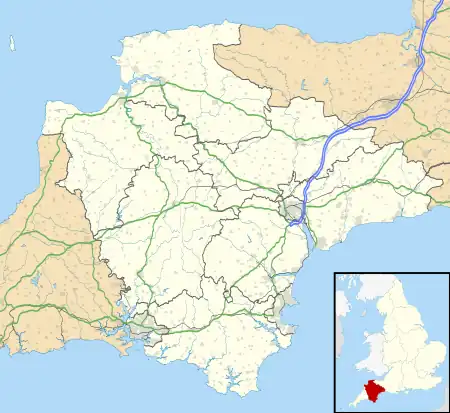Lustleigh Cleave
The Lustleigh Cleave is a steep sided valley above the River Bovey[1] in the parish of Lustleigh on Dartmoor. The cleave has been noted for its beauty since the 1800s,[2][3] and features extensively in guidebooks.
| Lustleigh Cleave | |
|---|---|
 View onto Lustleigh Cleave | |
 Lustleigh Cleave Location in Devon | |
| Length | 2 miles (3.2 km) North West-South East |
| Geography | |
| Coordinates | 50.621°N 3.747°W |
| River | River Bovey |
Description
The Lustleigh Cleave is a steep-sided valley, approximately 2 miles (3.2 km) in length, with the River Bovey flowing at the bottom approximately South-Easterly.[4]
Nothing can spoil the Cleave, where the granite, piled up like giants' castles, crowns the gorge, and is spread all the way to the stream below.
— Cresswell, 1920[5]
The valley is scattered with granite clitter (rocks strewn across the landscape), including rocking logan stones.[6]
Notable features
The cleave contains Hunter's Tor, a granite tor, typical of Dartmoor, and location of an Iron Age settlement, and later Domesday book settlement of Sutreworde.[7][8]
References
- Crossing, William (1914). Guide to Dartmoor; a topographical description of the forest and the commons. Plymouth Western Morning News Co. p. 72.
- Rowe, Samuel (1898). A perambulation of the antient and royal forest of Dartmoor and the Venville precincts, or a topographical survey of their antiquities and scenery. JG Commin. p. 136.
- Nicholls Worth, Richard (1880). Tourist's guide to South Devon. London: Edward Stanford. pp. 76–77.
- Crossing, William. Gems in a granite setting; beauties of the lone land of Dartmoor. pp. 75–79.
- Cresswell, Beatric F (1920). Dartmoor with its surroundings; a handbook for visitors. London Homeland Association. p. 34.
- Rowe, Samuel; Rowe, Joshua Brooking (1896). A perambulation of the antient and royal forest of Dartmoor and the Venville precincts, or a topographical survey of their antiquities and scenery. Exeter: JG Commin. pp. 136–137.
- "Hunter's Tor (Lustleigh)". Tors of Dartmoor.
- Mortimer, Ian (December 2021). "The Location and Extent of King Alfred's Suðewyrðe". Reports and Transactions of the Devonshire Association for the advancement of Science. 153: 227–254.